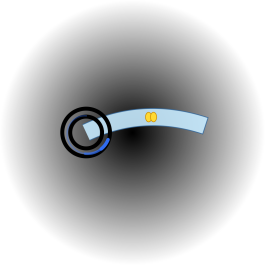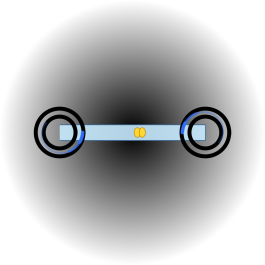Home / Chapter 5: Microscopic Particles
One-Sentence Overview:
In the materialized picture of Energy Filament Theory (EFT), a quark is not a point but an open unit composed of a “micro-filament core” plus an outward “color channel.” The core is a very short, tightly wound local knot that sets the baseline for chirality and part of the spin and self-supporting energy. The color channel is a high-tension corridor pulled out of the surrounding energy sea. It is not a literal tube wall nor a second filament; it must dock with other quarks to balance the energy ledger and close the structure. As a result, only color-neutral composites (mesons, baryons, or gluon-rich bound states) persist, and isolated quarks cannot be separated at macroscopic scale.
I. Minimal Physical Picture: Core + Color Channel (Three Colors = Three Interchangeable Paths)
- Filament Core:
- A tiny knot of an energy filament within the energy sea. It sets chirality and contributes to spin and inertia (self-supporting energy). Differences among flavors (up, down, strange, charm, bottom, top) can be understood as differences in winding order and phase modes.
- Color Channel (Color Filament Corridor):
- Scope: It is not the filament body being pulled out. Instead, a color port at the core excites a tensile corridor in the energy sea. “Color” refers to three independent yet interchangeable orientation paths.
- Confinement orientation: When a composite’s three orientation vectors sum to zero (color-neutral), the far field closes and the structure is stable.
Clarification: The color corridor is not a solid object; it is a tensile–orientation band formed in space. Gluons are packets of phase–energy that propagate along this corridor during an exchange or reconnection event; they are not little balls.
II. Materialized Explanation of Confinement: Why We Never See an Isolated Quark
Treat two separated quarks as linked by a high-tension corridor:
- The longer you pull, the more you pay: the corridor’s tension is roughly constant, so energy rises nearly linearly with distance.
- A cheaper exit: once a threshold is reached, the energy sea reconnects near the middle and nucleates a quark–antiquark pair (q–q̄), cutting the long corridor into two short corridors that each close as a meson.
Conclusion: Experiments observe jets and “meson rain,” not a single quark being plucked out.
III. How Hadrons “Assemble”: Mesons, Baryons, and the Y-Shaped Closure
- Meson (q + q̄):
- A near-straight color corridor docks two filament cores end-to-end; the whole is color-neutral.
- Baryon (q + q + q):
- Three color corridors converge into a Y-shaped junction in space. This costs less energy than a triangular perimeter. The three orientation vectors sum to zero and the whole structure closes.
- Gluon Exchange:
- Phase/flux packets run along corridors and shuttle “occupancy” among the three paths, manifesting as color exchange.
IV. Flavors (Up, Down, Strange, Charm, Bottom, Top): Winding Order and Lifetime
- Higher winding order or mode → higher nucleation cost → heavier mass and shorter lifetime, with decays tending toward lower orders.
- The top quark is extremely heavy and decays so quickly that it often fails to hadronize with others, which matches observation.
V. Mass, Charge, and Spin: Where the Ledger Adds Up
- Mass: Two Ledgers Combined
- Self-supporting energy of the filament core (bending/twisting).
- Tension energy stored in the color corridor (the corridor’s “energy inventory”).
- Therefore, the statement “most of the proton’s mass comes from the strong interaction” becomes a concrete picture: tension energy in thin corridors far exceeds any “bare mass” of quarks.
- Charge (Why in Thirds)
- A quark’s electromagnetic appearance arises from directional polarization in the near field around the core. Part of this directional “budget” is consumed by the color corridor, so its projection onto the electromagnetic appearance yields fractional units: up-type retains more (+2/3), down-type retains less (−1/3).
- Numerical alignment: charge values strictly match the mainstream values (±1/3, ±2/3); we only supply a materialized rationale, not new numbers.
- Spin (Who Contributes What)
- Effective spin comes from the core’s global twist plus torsional waves and gluon angular momentum within the corridor. Different internal hadron “allocations” explain spin-decomposition data, where quark spin accounts for only part of the total.
VI. Scale Behavior: Nearly Free at Short Range, Strongly Bound at Long Range
- Very Short Distance (High Q²):
- When cores approach each other, corridor cross-sections widen and impedance drops; exchanges resemble “wideband tunneling,” so quarks appear nearly free (asymptotic freedom).
- Pulled Apart (Low Q²):
- Corridors become thinner and tighter; energy grows approximately in proportion to distance. The system tends to break and pair-create, returning to a closed hadronic form (confinement).
In this way, asymptotic freedom and confinement live on the same energy ledger.
VII. Cross-Walk to the Standard Model (Terminology Translation, Not a Fight)
- Three colors ↔ three orientation corridors (a geometric visualization of color paths).
- Gluons ↔ phase/flux packets running along corridors that “deliver occupancy,” not tiny spheres.
- Confinement and jets ↔ linear energy growth with distance plus reconnection-driven pair creation.
- Hadron internals ↔ meson straight-corridor closure and baryon Y-junction closure.
- Mass mainly from the strong interaction ↔ corridor tension plus core self-support dominate.
- Fractional charge ↔ near-field polarization after “budget consumption” by color corridors projects to electromagnetic thirds.
- No hadronization for the top quark ↔ nucleation time exceeds decay time.
VIII. Boundary Conditions (Essentials Aligned with Existing Data)
- Deep Inelastic Scattering (DIS) and Partons:
- At high Q² and in deep inelastic scattering, the picture converges to the familiar parton view; established parton distribution functions (PDFs) and scaling behavior remain intact.
- Electromagnetic Consistency:
- Charge values stay fixed at ±1/3 and ±2/3. Electromagnetic form factors and their energy dependence remain aligned with measurements.
- Spectroscopy and Hadronization:
- Resonance spectra, jet topologies, and fragmentation functions stay within error bands. The intuitive language of “linear potential and pair-creation breaks” must not introduce spurious peaks.
- Conservation and Dynamical Stability:
- Conservation of color, flavor, energy, momentum, angular momentum, and baryon number holds strictly. No “cause follows effect” quirks or runaway instabilities.
- Visualization ≠ New Numbers:
- All corridor/packet/Y-junction metaphors are intuitive translations only; mainstream parameters and fits remain unchanged.
One-Sentence Wrap-Up
A quark is a micro-filament core plus a color corridor. The corridor is a high-tension path drawn from the energy sea that locks multiple cores into a color-neutral whole. The more you pull, the higher the cost, until reconnection spawns a new pair and returns the system to closed hadrons. This is why we observe jets and hadrons rather than isolated quarks, and why mass, spin, and fractional charge each find a natural place on this materialized map.
Figures
- Single-Quark Unit (Core + Nascent Corridor)

- Emphasis: A single quark is open-ended; it needs corridor docking with others to be stable.
- Reading anchors: double ring = core; light-blue arc-band = color corridor; yellow = gluon packet; gray gradient = shallow basin.
- Gluon: A yellow “peanut-shaped” packet rides along the corridor, representing a phase–energy packet for one exchange or reconnection event, not a tiny sphere.
- Phase front: A blue phase arc on the core with a thickened leading edge suggests phase-locked timing.
- Main body: A filament core on the left (a small double ring indicating a thick, self-supported center). A light-blue arc-band extends to the right as the color corridor (a tensile path, not a solid tube).
- Meson (q + q̄, Straight-Corridor Closure)

- Emphasis: A meson is a “single straight corridor” closed at both ends.
- Reading anchors: double rings at both ends = q and q̄ cores; light-blue band between = corridor; yellow packet = gluon; no electric arrows (color-neutral).
- Phase fronts: A blue phase arc at each end; a yellow gluon packet sits mid-corridor to indicate color exchange.
- Main body: One core on each side, docked by a near-straight corridor that closes the whole as color-neutral.
- Baryon (See Sections 5.6 Proton and 5.7 Neutron)
- Three quarks with three corridors merging at a central Y-junction. Other layers (core double lines, blue phase arcs, transitional “pillow,” far-field fine lines and concentric gradient) follow the same visual system.
Copyright & License (CC BY 4.0)
Copyright: Unless otherwise noted, the copyright of “Energy Filament Theory” (text, charts, illustrations, symbols, and formulas) belongs to the author “Guanglin Tu”.
License: This work is licensed under the Creative Commons Attribution 4.0 International (CC BY 4.0). You may copy, redistribute, excerpt, adapt, and share for commercial or non‑commercial purposes with proper attribution.
Suggested attribution: Author: “Guanglin Tu”; Work: “Energy Filament Theory”; Source: energyfilament.org; License: CC BY 4.0.
First published: 2025-11-11|Current version:v5.1
License link:https://creativecommons.org/licenses/by/4.0/